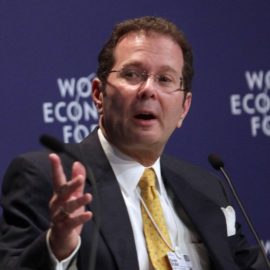

This article is an excerpt from the Shortform book guide to "Onward" by Howard Schultz. Shortform has the world's best summaries and analyses of books you should be reading.
Like this article? Sign up for a free trial here.
What’s the innovation strategy of Starbucks? What cuts did CEO Howard Schultz have to make to raise Starbucks’s profits?
One of Schultz’s initial turnaround strategies in 2008 was to improve Starbucks’ financial standing. He achieved this by focusing on two objectives: frugalizing operations and shifting in focus from expansion to innovation.
Let’s explore these innovative changes in more detail.
Frugalizing Operations
Schultz explains that by the second quarter of 2008, Starbucks was in dire straits as it experienced a historic low in sales earnings. Costs needed to be cut immediately to make room for an innovation strategy of Starbucks, so he asked a new executive to evaluate the performance of US stores. This executive decided to close 600 underperforming US locations, many of which had been opened haphazardly (without adequate consideration of revenue potentials) in the last three years. Starbucks also laid off 550 corporate employees to cut costs. Schultz explains that in both cases, the company endeavored to smoothly transition as many employees as possible to other roles; if that wasn’t possible, the employees received professional assistance or generous severance packages.
(Shortform note: Business analyst John Quelch says that one reason Starbucks had to close so many stores was that it reached market saturation—the point at which demand for a product is fully met by supply, resulting in decreased sales growth and increased competition among suppliers. In Starbucks’ case, this often meant there were too many stores in one area—they had to steal customers from each other to survive, cutting down on each store’s profitability. Starbucks’ efforts to ameliorate the damage caused by closures and layoffs may have improved remaining employees’ morale and preserved Starbucks’ image as a caring institution.)
By the end of 2008, profits were still down and there was no sign of economic recovery, so Starbucks’ board asked Schultz to make further cuts. Internal research showed that Starbucks was hemorrhaging money due to in-store inefficiencies, like too much food waste and wasteful labor scheduling procedures, as well as inefficient supply chain operations. In response, Schultz and his executive team made $400 million in cuts. They didn’t want to take such an aggressive approach but did so at the board’s behest. Schultz explains that this turned out to be a good call because it reassured analysts at Starbucks’ next analyst meeting, which had a slightly positive impact on Starbucks’ stock value (though it still loomed near its all-time low).
(Shortform note: At an analyst meeting, corporate executives give equity analysts—financiers who make recommendations to investors—information about their company’s financial performance and future directions. Since equity analysts tell investors whether it’s wise to invest in or pull out of a company, they play a significant role in determining a company’s stock values. Analysts value cost-cutting measures when they seem certain to boost a company’s immediate and long-term financial prospects, so experts say executives must think critically about which cuts are worth making. Supply chain inefficiencies are one of the most common short- and long-term bleeds companies experience, so it was prudent for Starbucks to start there.)
Shifting in Focus From Expansion to Innovation
Schultz says that the decision to close hundreds of locations underscored the problem with Starbucks’ growth strategy: Expanding the company’s geographic reach was not always good for business. This meant he needed to nurture a more effective strategy to reach new customers: innovation. Starbucks created three new products: a slushie-like drink called Sorbetto, a smoothie called Vivanno, and an instant coffee called Via. Schultz expected Sorbetto to revitalize sales and solve Starbucks’ problems, but its high production costs and sugar content led to its failure. Vivanno was slightly more successful because it was healthier, but it launched at the same time as Sorbetto and didn’t get the marketing attention it deserved.
Schultz explains that the instant coffee Via, developed for sale in grocery stores, was harder to roll out than Sorbetto and Vivanno. This was partially because he received pushback from other executives who feared that selling an instant coffee would degrade their brand (since instant coffee is notoriously inferior to brewed coffee and Starbucks prides itself on quality). But Schultz’s data told him that instant coffee could be immensely profitable and help Starbucks reach new customers without sacrificing quality, so he persisted. Schultz explains that Via was immensely successful in three ways: Critics liked it and it sold well immediately, it revitalized the company’s entrepreneurial spirit, and it proved innovation was a wise growth strategy.
| Why Innovation Works—and What to Do When It Doesn’t More than a decade after Schultz published Onward, Starbucks was still rolling out innovative new products in an effort to meet more consumers’ needs. For example, when analysts showed in 2023 that consumers enjoy healthy snacks and teas more than ever, Starbucks announced plans to expand their menu offerings in those areas. But over the years, many of these innovations have failed—including Sorbetto, which failed to evoke the Italian ambiance Schultz hoped for, and Vivanno, which was too nutritious to serve as the casual beverage consumers wanted. In an interview, Schultz explained that some of Starbucks’ most spectacular failures—including an early magazine venture—inspired him to encourage further innovation because they were proof of Starbucks’ bravery. Leadership consultant Brené Brown affirms this wisdom in Daring Greatly, arguing that innovation is an inherently vulnerable experience because it’s emotionally risky—it could lead to disappointment or rejection. According to Brown, good leaders are willing to take on those risks and actualize possibilities by innovating. Besides being a hallmark of good leadership, innovation is also associated with greater company success. If an innovation fails but you want to encourage further experimentation, experts recommend reframing the way you see failure: Think of it as part of the process, rather than a dead end, and commit to trying again. Proof of this strategy’s effectiveness can be found in Via instant coffee—if Starbucks had stopped innovating because Sorbetto and Vivanno failed, it wouldn’t have come up with Via, which is still sold today in a variety of flavors. |

———End of Preview———
Like what you just read? Read the rest of the world's best book summary and analysis of Howard Schultz's "Onward" at Shortform.
Here's what you'll find in our full Onward summary:
- Why Starbucks CEO Howard Schultz left and later returned to the company
- Schultz’s three-part strategy that saved Starbucks from potential ruin
- Why millions of people love Starbucks’ coffeehouse experience






